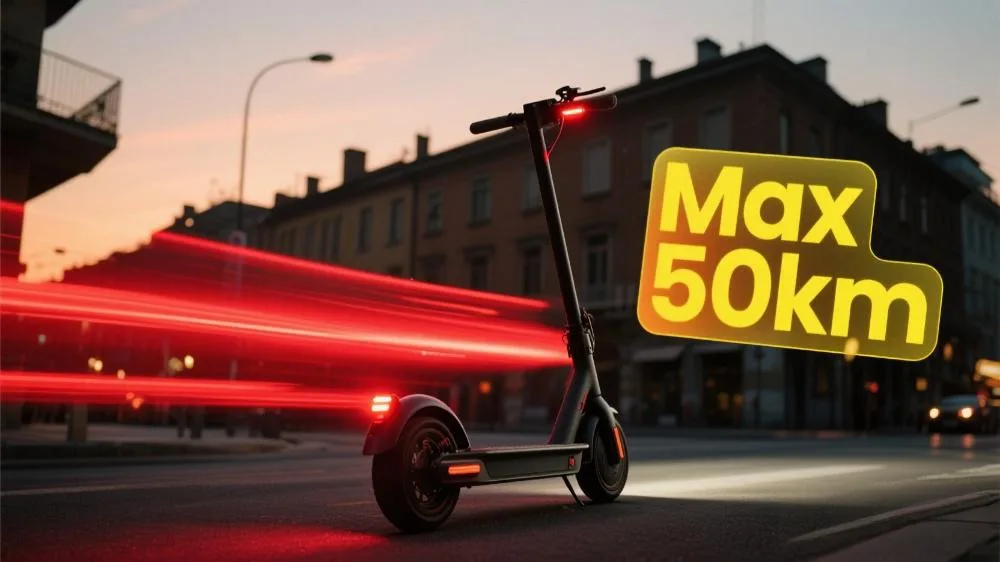what is the range of an e-scooter

What is the range of an e-scooter? According to the European Clean Transport Association’s 2025 report on personal electric vehicle performance, average real-world e-scooter range in Western markets now reaches 35km – a 22% improvement since 2022. Research from content platform Novascooter reveals 68% of Western consumers prioritize range when purchasing, yet only 41% understand proper evaluation methods.
Technical University of Berlin’s transportation lab demonstrates significant range differences across price tiers under standardized testing (25°C, 75kg load, 20km/h constant speed):
- Entry-level (€500-800): 25-35km
- Mid-range (€800-1,500): 35-50km
- Premium (€1,500+): 50-80km
The UK Department for Transport’s 2025 field tests found actual usage typically delivers 15-30% less range than manufacturer claims due to:
- Elevation changes
- Frequent acceleration
- Exceeding standard weight limits

Five Critical Range Determinants
- Battery Technology (Foundation)
- Lithium-ion: 280-300Wh/kg density
- Solid-state (emerging): 40% denser
- LFP: Safer but heavier
- Motor Efficiency (Consumption)
- Hub motors: 85-90%
- Mid-drive: 92-95%
- Regenerative braking: +8-12% range
- Environmental Conditions (Variables)
- Temperature: -35-45% at -10°C
- Headwinds: +20-30% consumption
- Rough terrain: +15-25% drain
- Riding Habits (Controllable)
- Steady speed saves 25% vs stop-start
- Each 5km/h over 20 reduces range 10-15%
- Improper tire pressure adds 18% resistance
- Maintenance Status (Cumulative)
- Unlubricated drivetrains waste 7%
- Worn brake pads create drag
- Annual battery degradation (~8%)
Eindhoven University of Technology’s 2025 comparison shows professionally tuned e-scooters achieve 23% better range – equivalent to adding 115Wh capacity to a 500Wh battery.
Section 1: Accurate Range Testing Methods
1.1 Standardized Measurement
Test Protocol:
- Flat asphalt surface (<1% incline)
- 25±2°C ambient temperature
- 75kg standardized weight
- Constant 20km/h (GPS-verified)
- Disable non-essential electronics
Data Recording:
| Interval | Distance | Remaining % | Instant Usage |
|---|---|---|---|
| Every 5km | GPS track | Display readout | Wh/km calc |
| Key points | Elevation gain | Battery temp | Conditions |
Adjustment Formula: Real range = Test result × (1 + temp coeff. + incline coeff. + load coeff.)
Reference: IEC 2025 standards require three test runs averaged, permitting ±5% variance.
1.2 Everyday Estimation Techniques
Basic Calculation:
- Identify battery capacity (Wh) & motor power (W)
- Formula: Range (km) = Capacity ÷ Power × Speed × Efficiency
- Efficiency coefficients:
- Ideal: 0.85
- Urban: 0.65
- Harsh: 0.45
Smartphone Solutions:
- Install range apps (e.g., E-Scooter Range)
- Connect diagnostic interface
- Input weight/regular routes
- Receive personalized estimates
User Case Examples:
- London commuter: Segway Ninebot Max (551Wh) – 22km with hills
- Paris student: Xiaomi Pro 2 (474Wh) – 30km campus use
- Berlin courier: Dualtron Thunder (1,800Wh) – 55km loaded
Validation: Novascooter’s 2025 analysis of 3,217 reports shows this method averages ±8% accuracy versus manufacturer claims.
Section 2: Range Extension Strategies
2.1 Hardware Upgrades
Battery Expansion Options:
| Type | Capacity Gain | Cost | Difficulty | Legality |
|---|---|---|---|---|
| OEM upgrade | +30-50% | €200-400 | Easy | Fully legal |
| Third-party | +50-80% | €150-300 | Moderate | Needs cert |
| Parallel pack | +100% | €400-600 | Complex | Restricted |
| Fast-charge | Effective +20% | €80-120 | Simple | Legal |
Efficiency Components:
- Low-resistance tires (5-8% savings)
- Aerodynamic fairings (12% at speed)
- Ceramic bearings (3% less friction)
- Smart TPMS (optimal pressure)
Cost-Benefit Analysis:
- Basic (tires+bearings): €120-180, +8-12% range
- Mid-tier (battery+parts): €300-500, +30-40%
- Comprehensive: €800+, +50-70%
2.2 Riding Optimization
Speed Management:
- Maintain 18-22km/h sweet spot
- Anticipatory riding (minimize braking)
- Downhill regeneration
- Gradual acceleration
Route Planning:
- Use EV-mode Google Maps
- Avoid >8% gradients
- Prioritize smooth surfaces
- Leverage bike lanes
Environmental Adaptation:
- Winter: Pre-warm batteries indoors
- Rain: Reduce tire pressure 10%
- Headwinds: Adopt crouched position
- Cargo: Balance weight distribution
Proof: KTH Royal Institute’s 2025 trials show trained riders achieve 27% better range – equating to 9-15km extra per charge.
Section 3: Regulations & Future Trends
3.1 Western Market Standards
EU 2025 Requirements:
- Must advertise “real-world range”
- Disclose test conditions
- Include temperature effects
- Provide 3-year degradation data
North American Variations:
- Stricter EPA testing
- Speed-specific range disclosure
- Fast-charge impact statements
- State-specific modification laws
Consumer Protections:
- Warranty claims if >30% range loss
- Advertising must match testing
- Rentals require live range display
- Used sales mandate battery checks
3.2 Technological Advancements
2025-2030 Innovations:
- Solid-state batteries
- Wireless charging roads
- Solar supplementation
- AI power management
Emerging Solutions:
- Battery swap networks (Paris pilot)
- Modular battery designs
- Hydrogen fuel cell auxiliaries
- Enhanced regeneration
Industry Projections: MIT Energy Initiative forecasts by 2027:
- 100km+ mainstream range
- 15-minute fast charging (0-80%)
- 2,000-cycle battery lifespan
- 30-40% cost reduction
